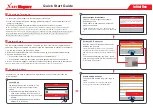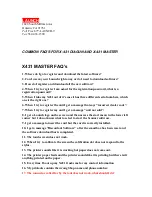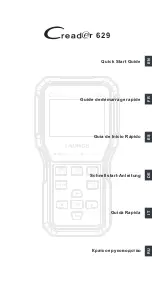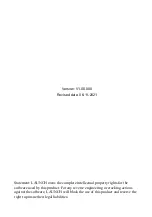
Operator's Manual
WP700Zi-OM-E-RevA
470
Analog Threshold:
This is the user-specified threshold used by Analog Compare to decide when to record an
error. A typical value for the Analog Threshold might be about 0.025. See
Note 1
below.
Additionally, these parameters are useful (but not essential) for Analog Compare:
Read Gate:
If the Read Gate signal is available, it will be used as described in
Note 2
, below.
Read Gate Polarity:
Typically, Read Gate is a positive true signal. However, there are drives that use a negative
true signal for Read Gate. If Read Gate is enabled, this setting allows you to select whether "True" is high or low.
Read Clock:
If present, the Read Clock signal is used to determine where the "sample time" markers are drawn.
Use Analyze Region:
As previously described, markers can be used to define a subset of the head signal for
analysis.
Bit Cell Time:
If specified, will be used to determine window size for comparison, otherwise a default value is
used.
Code Rate:
If provided, this is used to determine the size of an encoded byte, which is needed in determining the
window size for Analog Compare.
Filter Head Signal:
If enabled, an equalization filter is applied to the head signal before processing and display.
This feature should be used if the DDA does not have access to the drive's equalized head signal.
After the setup is complete, a reference waveform should be acquired and saved by touching
Store Reference
.
Notes on Using Head/Analog Compare
1.
Setting Analog Threshold: The "Analog Threshold" sets how large the difference (mean squared distance)
between the reference and the acquisition must be to be recorded as an "error". A threshold of zero means
that even the slightest difference will be enough. The threshold is normalized to full scale, which means
that a setting of 1.000 specifies that the signals must mismatch by full scale over the entire three byte wide
analysis window to be recorded as an error. DC mismatch is compensated and does not contribute to
"mismatch".
If the waveform amplitude can be -full scale to +full scale, the formula relating threshold to number of
divisions mismatch (without vertical zoom) -- average over the analysis window -- is: sqrt(thresh). For
example, a threshold of 0.015 corresponds to 0.49 of a division average mismatch within the window.
2.
Analog Compare works best if it can analyze VCO Synch at the beginning of its analysis region for both the
reference and the head signal. If Read Gate is available it should be able to do that.
If Read Gate is not available, the "Analyze Region" cursors can be turned on and the "start" marker
positioned near the beginning of a VCO Synch field. This also will let Analog Compare analyze the VCO
Synch field and align reliably.
If Read Gate is not available, and VCO Synch is not available, then Analog Compare attempts to align the
signals up to about 12 bit cells difference. Note that if the start of the analysis region is far from the t=0
(trigger) position then small speed variations can cause the waveforms to be too misaligned for Analog
Compare to be correct. For example, if the start of the analysis region is 15,000 bit cell times after the
trigger, a 0.1% speed variation gives 15 bit cell times of jitter at the start of the analysis region. No matter
how it achieves alignment, Analog Compare attempts to maintain alignment for up to a 1% speed
mismatch.
Analog Compare compensates for misalignment in the reference and acquisition based on the first Read
Gate edge (if a source of Read Gate has been specified), and if it can analyze VCO Synch, on the end of
the VCO Synch in that first section. If Read Gate is being used and the reference contains multiple Read
Gate true sections, then the timing between them in the reference and the acquisitions must match within
the alignment tolerance of Analog Distance, about 12 bit cells.
3.
The reference waveform must be the same as the waveforms it is compared to. That means it must be the
same length, acquired at the same horizontal and vertical scales. The same regions of the new and
reference waveform will be compared. That means it is not possible to store a reference of a single sector
and compare it to subsequent acquisitions containing multiple sectors. It is also not possible to compare a
split sector to an unsplit or differently split sector. The reference and the acquisition must basically match.
Содержание DDA 7 Zi series
Страница 1: ...Operator s Manual WavePro SDA and DDA 7 Zi Series Oscilloscopes ...
Страница 2: ... L R R H HUD RU D D ...
Страница 41: ...Operator s Manual WP700Zi OM E RevA 40 The detachable WavePro Zi front panel ...
Страница 376: ...WavePro 7Zi 375 WP700Zi OM E RevA Absolute Offset Relative ...
Страница 439: ...Operator s Manual WP700Zi OM E RevA 438 ...
Страница 440: ...WavePro 7Zi 439 WP700Zi OM E RevA ...
Страница 544: ...Thank you for purchasing a WavePro SDA or DDA 7 Zi Oscilloscope ...
















































